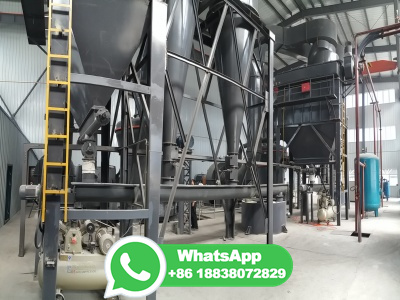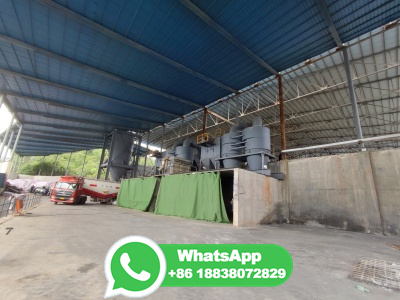Iron Ore PRICE Today | Iron Ore Spot Price Chart | Live Price of Iron ...
Iron Ore Price: Get all information on the Price of Iron Ore including News, Charts and Realtime Quotes.

Iron Ore Price: Get all information on the Price of Iron Ore including News, Charts and Realtime Quotes.

The basic parameters used in ball mill design (power calculations), rod mill or any tumbling mill sizing are; material to be ground, characteristics, Bond Work Index, bulk density, specific density, desired mill tonnage capacity DTPH, operating % solids or pulp density, feed size as F80 and maximum 'chunk size', product size as P80 and maximum a...

A ball mill is a type of grinder used to grind or blend materials for use in mineral dressing processes, paints, pyrotechnics, ceramics, and selective laser sintering. It works on the principle of impact and attrition: size reduction is done by impact as the balls drop from near the top of the shell.

Abstract The fine grinding of ores is increasing due to the depletion of coarse grained, easily processed ore bodies and the increased need to process disseminated, fine grained deposits. The main reason ball mills are not utilised for fine grinding is the perceived poor energy efficiency generally experienced when grinding to fine sizes.

The generation of iron ore fines in dry processing plant of Khondbond region, India is about 3040% of the total feed. The iron ore fine assayed % Fe (T), % Al 2 O 3, % SiO 2, and % LOI. Particle size distribution of fines showed that 50% (by weight) of material are below 1800 μm.

Beneficiation of Iron Ore and the treatment of magnetic iron taconites, stage grinding and wet magnetic separation is standard also applies to iron ores of the nonmagnetic type which after a reducing roast are amenable to magnetic separation. All such plants are large tonnage operations treating up to 50,000 tons per day and ultimately requiring grinding as fine as minus 500 ...

In the field of extraction metallurgy, the direct reductiongrinding separation process is an effective technology, especially for the treatment of vanadium titanium magnetite and lowgrade iron ores [1], [2], [3].Direct reduction is a process in which gaseous (H 2, CO) or solid reducing agents (coal, biomass) are used to reduce the metal oxides in the ore to metallic elements under solid ...

An effect of a grinding method, that is ball mill and high pressure grinding rolls (HPGR), on the particle size, specific surface area and particle shape of an iron ore concentrate was studied. The particle size distribution was meticulously examined by sieve, laser and image analyses.

1. Change grindability of iron ore. The particle size distribution of raw materials fed into the ball mill is one of the reasons that endanger the energy consumption of the ball mill steel ball ...

Steel balls as traditional grinding media are prone to excessive fines generation and high energy consumption. Therefore, in light of this problem, the authors investigated another media—ceramic balls based on the output characteristics of fine particles. This study discusses the effect of ceramic balls on the change of the particle size distribution, zeroorder output characteristics, micro ...

The iron ore fines/carbon composites were heated from room temperature up to 1100 °C with different heating rates (5, 10, 15, and 20 °C/min) under an argon atmosphere. ... First, the raw materials (iron ore fines and charcoal or coal) were mixed in a ball mill with a speed of 180 rpm for 1 h to ensure complete homogeneity. The amount of ...

The 3mesh ROM iron ore sample, collected from Barsua iron ore mines of Odisha, was crushed in a dodge type jaw crusher. The crushed product was passed through a roll crusher, which was then ground to passing 200mesh in a ball mill. This head sample was used for characterization. Beneficiation studies were carried out after grinding

Gulin provide the ball mills iron ore equipment solution case for . Ball Mill for Gold Mine in Zimbabwe,Gold Grinding Plant for Sale Gold grinding is a unit process used in a broad range of industrial application to produce fine . low mill capacity and high . crushing process completes.

Iron ore occurs naturally in a variety of forms, from sandlike iron fines to solid rock masses. Crude ore, or ore mined in the natural state, seldom occurs in a pure state and requires some form ... In the grinding circuit, rod, ball, or autogenous mills grind the taconite down into even smaller uniformedsized particles. The ore is ground ...

Iron ore fines from Bailadila have been grounded in a Ball mill to—1000 micron size. A sample is collected from the Ball mill product and analyzed for its size distribution and metal values. The data| is given in the table. Calculate the %Fe in Ball mill product. Size. Mal product %Fe 1000 +850 6'14 + 540 500 + 212 212 + ISO 154+075 ...

Singleparticle compression tests discriminated well iron ore concentrate characteristics. • Energy utilization appeared as a good measure to discriminate between materials amenability for breakage at such fine sizes. • Higher efficiency for rigidlymounted roll mill and pistonanddie, followed by labHPGR and ball mill.

Six steps to process iron ore. 1. Screening. We recommend that you begin by screening the iron ore to separate fine particles below the crusher's CSS before the crushing stage. A static screen is used to divert the fine particles for crushing. This step prevents overloading the crusher and increases its efficiency.

Working Principle Technical Data Ore Ball Mill Details Ore ball mill sometimes called ore grinding mill, is generally used in mineral processing concentrator, processing materials include iron ore, copper ore, gold ore, molybdenum ore and all kinds of nonferrous metal ore.

The ore from the feeder next passes over a roll or vibrating grizzly. For the small 150 to 200 ton per day mill this opening can be 2 inches. This will allow the wet sticky fines to pass through the grizzly. A high pressure water spray over the grizzly often aids in the subsequent jaw crusher operation.

Fig. 3 shows the different types of mills with reference to their key application and the corresponding possible feed and product particle sizes [4]. Typical types of mill used in ore beneficiation are autogenous (AG) and semiautogenous (SAG) mills together with ball mills to, for example, obtain particle sizes smaller than 100 µm.

The ball mill was grinding to a P 80 of 50 to 70 µm, therefore the traditional marker size (75 µm) ... Davis,, 1919. Fine crushing in ballmills. Transactions of the American Institute of Mining Engineers 61, 250296. Hukki,, Allenius, H., 1968. A quantitative investigation of the closed grinding circuit. Society of Mining Engineers ...

Idaho LeadZincIron Ore: "The Flash Flotation Cell is removing direct from the grinding circuit over 70% of the total lead recovered in the entire plant. This phenomenal recovery is made by a Unit Flotation Cell installed between the ball mill and classifier, and a coarse high grade rougher concentrate averaging 65% to 70% lead is obtained ...

Q5. (20 points) Iron ore fines from Bailadila have been grounded in a Ball mill to 1000 micron size. A sample is collected from the Ball mill product and analyzed for its size distribution and metal values. The data is given in the table. Calculate the %Fe in Ball mill product.

Most of the highgrade hematite iron ores are typically subjected to simple dry processes of crushing and classification to meet the size specifications required for direct shipping ore (DSO). This involves multistages of crushing and screening to obtain lump (− + mm) and fines (approximately − mm) products.

Type CHRK is designed for primary autogenous grinding, where the large feed opening requires a hydrostatic trunnion shoe bearing. Small and batch grinding mills, with a diameter of 700 mm and more, are available. These mills are of a special design and described on special request by all Ball Mill Manufacturers.

Understanding Pellets and Pellet Plant Operations. Pelletizing is an agglomeration process which converts very fine grained iron ore into balls of a certain diameter range (normally 8mm to 20 mm, also known as pellets. These pellets are suitable for blast furnace and direct reduction processes.

Convective drying experiments were performed using laboratoryscale equipment in order to obtain drying kinetics data for iron ore fines at air temperatures up to 140 °C and air velocities up to ...

Materials were ground in a lab scale ball mill for 2hours with steel balls and size analysis of products were carried out using different size sieves (1,,,, and ). ... and fine mineral association on iron ore particles. The density of samples was measured using conventional density bottle method.